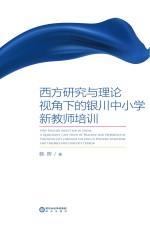

西方研究与理论视角下的银川中小学新教师培训PDF电子书下载
- 电子书积分:13 积分如何计算积分?
- 作 者:韩煦著
- 出 版 社:阳光出版社
- 出版年份:2016
- ISBN:9787552532722
- 页数:398 页
Part Ⅰ Research Design 1
Chapter 1 Introduction 1
1.1.Statement of the Problems 1
1.2.Purpose and Significance of the Study 2
1.3.Research Questions 4
1.4.Theoretical Framework for the Study 6
1.5.Structure of the Thesis 9
Chapter 2 Literature Review 13
2.1.Introduction 13
2.2.The Chinese Context 14
2.2.1.Decentralization and Its Impact on Teacher Education 14
2.2.2.Professionalization,Quality Education and Curriculum Reform 17
2.2.3.Teacher Induction 21
2.2.4.Summary 24
2.3.Review of a Selection of the Western English Language Literature 25
2.3.1.Overview 25
2.3.2.What do New Teachers Need?-Maslow's Hierarchy of Needs 27
2.3.3.What if the needs are not met? 39
2.4.What Can Be Done to Help New Teachers? 41
2.4.1.What is Induction and Why Induction? 41
2.4.2.Comprehensive Approaches to Induction 44
2.5.Emerging Themes 50
2.5.1.Teacher Identity 50
2.5.2.Professional Identity as Contextual,Relational and Emotional 53
2.5.3.The Awareness of the Professional Identity 56
2.5.4.The Narrative Constitution of identity 57
2.6.Summary 58
Chapter 3 Methodology,Research Design,and Methods 62
3.1.Overview:an Interpretive Case Study 62
3.2.Method of Inquiry:A Narrative Approach 63
3.3.Combining Narrative Interviews with Topical Interviews:Developing a Frame-work for Interviews 67
3.3.1.Overview 67
3.3.2.The Narrative Interview 69
3.3.3.The Topical Interview 72
3.3.4.Combining the Two Approaches 73
3.4.Participants and Data Collection Process 74
3.4.1.Initial Planning of Participants Selection and Data Collection 74
3.4.2.Phase One Data Collection and Some Reflections 76
3.4.3.Overview of Data Collection Process 80
3.5.Data Analytical Approach:a Voice-centred Relational Approach 82
3.5.1.Overview 82
3.5.2.A voice-centred relational method of data analysis(VCR) 83
3.5.3.Summary 97
3.6.Reliability,Validity and Generalisability 98
3.7.Ethical Considerations 100
3.8.Summary 101
Part Ⅱ Analysis and Discussion of Findings 103
Chapter 4 Induction Programme 103
4.1.Overview 103
4.2.Induction Policy Directives and Programme Arrangement 104
4.2.1.An Overview of the System in Yinchuan 104
4.2.2.Context 105
4.2.3.Induction Policy Directives 106
4.2.4.Induction Programme Emphases and Implementation 109
4.2.5.Teacher Assessment 121
4.2.6.Evaluation 125
4.3.Beginning teachers'expectations about and attitudes towards induction 126
4.3.1.Support Expected by New Teachers 127
4.3.2.Common Induction strategies experienced by new teachers 137
4.4.Summary and Discussion:Characteristics of Secondary School Induction Arrangement in Yinchuan-a Culture of Mentoring 148
Chapter 5 Job Motivation 155
5.1.Overview 155
5.2.Entry into the Profession 158
5.2.1.Entry into the ITT Programme 158
5.2.2.Entry into Teaching 160
5.2.3.Summary 163
5.3.Beginning Teaching 165
5.3.1.Working with Children 168
5.3.2.Working with Colleagues 176
5.3.3.Conflict with Individual Principles 179
5.3.4.Responsibilities,Workload and Recognition 186
5.3.5.Employment Status and Career Directions 192
5.4.Summary and Discussion 196
Chapter 6 Self-Image 200
6.1.Overview 200
6.2.Beginning Teachers'Self-Images 205
6.2.1.Early Experiences 205
6.2.2.Qualification and Employment Status 214
6.2.3.Professional Relationship with Students 221
6.2.4.Professional Relationships with Mentors and Colleagues 229
6.2.5.School and Academic Subjects 240
6.3.Summary and Discussion 245
Chapter 7 Subjective Educational Theory 250
7.1.Overview 250
7.2.Beginning Teachers'Subjective Educational Theories 257
7.2.1.Being a Learner and Conception of Professional Learning 257
7.2.2.Routines and Practical Knowledge 266
7.2.3.Pedagogical Perspectives 273
7.3.Summary and Discussion 282
Part Ⅲ Conclusion 292
Chapter 8 Conclusion 292
8.1.Overview 292
8.2.Answers to Research Questions 293
8.2.1.Beginning Teacher Induction in Yinchuan City 293
8.2.2.The First Year of Teaching 296
8.2.3.Summary 302
8.3.Limitations to This Research 304
8.4.Implications 306
8.4.1.Implications for Teacher Education and Induction 307
8.4.2.Implications for Future Research on New Teacher Induction 309
8.5.A Final Word 311
References 313
List of Tables 53
Table 2.1:Four Ways to View Identity 53
Table 3.1:Data Collection Process 81
Table 3.2:Story One 88
Table 3.3:Story Two 88
Table 4.1:Stage of Teacher Development 106
Table 4.2:Stages of Teacher Development 108
Table 4.3:Content of Induction Programme Curricula 111
Table 4.4:School A New Teacher Professional Development Plan 120
Appendices 348
Appendix 1:Short Explanations for Terms in Chinese 348
Appendix 2:Models of pre-service teacher preparation 350
Appendix 3:Six goals of the new curriculum reform 351
Appendix 4:Induction Support for new teachers in Shanghai 352
Appendix 5:Key Features of Limited versus Comprehensive Induction Programmes 354
Appendix 6:Interview Schedule 355
Appendix 7:Participants 366
Appendix 8:Consent Form 371
Appendix 9:The Life Story Method 374
Appendix 10:A sample of Pronouns Used by Mr.Fu 390
Appendix 11:School D Classroom Teaching Assessment Standard(2009-2010) 394
Appendix 12:Student-oriented Classroom Teaching Assessment Form 397
Appendix 13:Ningxia Secondary School Teachers Basic Teaching Qualities and Skills Test Form and Rating standard 398
- 《SQL与关系数据库理论》(美)戴特(C.J.Date) 2019
- 《联吡啶基钌光敏染料的结构与性能的理论研究》李明霞 2019
- 《情报学 服务国家安全与发展的现代情报理论》赵冰峰著 2018
- 《英汉翻译理论的多维阐释及应用剖析》常瑞娟著 2019
- 《信息系统安全技术管理策略 信息安全经济学视角》赵柳榕著 2020
- 《新课标背景下英语教学理论与教学活动研究》应丽君 2018
- 《党员干部理论学习培训教材 理论热点问题党员干部学习辅导》(中国)胡磊 2018
- 《大学英语教学的跨文化交际视角研究与创新发展》许丽云,刘枫,尚利明著 2020
- 《虚拟流域环境理论技术研究与应用》冶运涛蒋云钟梁犁丽曹引等编著 2019
- 《当代翻译美学的理论诠释与应用解读》宁建庚著 2019
- 《政治学与和谐社会》赵宝煦著 2009
- 《中国后妃列传》童煦著 1987
- 《风景园林徜徉录》沈福煦著 1992
- 《信息高速公路纵横谈》张煦著 1999
- 《水下及淤泥中施工与地基处理》杨光煦著 1998
- 《中国建筑文化简史》沈福煦著 2010
- 《建筑概论》沈福煦著 2011
- 《林下参种植光环境的动态预测与评价》刘煦著 2017
- 《三生有幸 幸福心理学的三种时间尺度》李晓煦著 2017
- 《小车嘀嘀嘀》韩煦著绘 2018
- 《中国十大出版家》王震,贺越明著 1991
- 《近代民营出版机构的英语函授教育 以“商务、中华、开明”函授学校为个案 1915年-1946年版》丁伟 2017
- 《国之重器出版工程 云化虚拟现实技术与应用》熊华平 2019
- 《新闻出版博物馆 总第33期》新闻出版博物馆 2018
- 《快乐阳光 少儿声乐艺术等级测评曲集 7-15岁 第七级》“快乐阳光”艺术委员会编;曹晶心执行主编 2019
- 《心有阳光 便能幸福》李宇晨 2018
- 《快乐阳光 少儿声乐艺术等级测评曲集 7-15岁 第二级》“快乐阳光”艺术委员会编;曹晶心执行主编 2019
- 《快乐阳光 少儿声乐艺术等级测评曲集 7-15岁 第九级》“快乐阳光”艺术委员会编;曹晶心执行主编 2019
- 《快乐阳光 少儿声乐艺术等级测评曲集 7-15岁 第一级》“快乐阳光”艺术委员会编;曹晶心执行主编 2019
- 《快乐阳光 少儿声乐艺术等级测评曲集 7-15岁 第八级》“快乐阳光”艺术委员会编;曹晶心执行主编 2019
